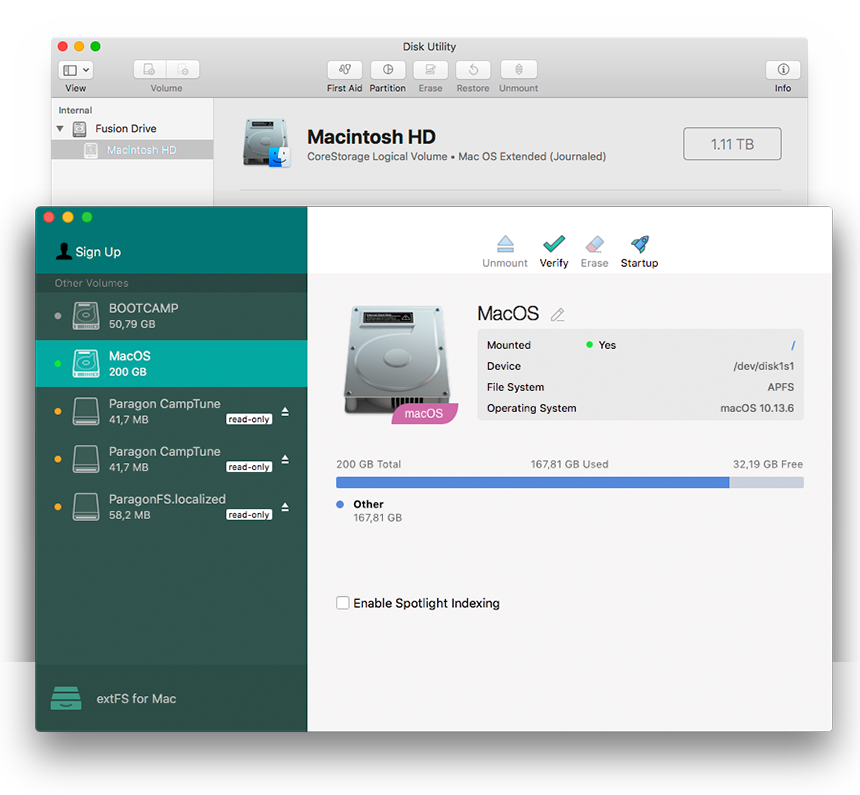Mount Xfs Windows
3) Mount the XFS partition in Linux. 4) Share it with Windows via Samba. Also you can boot any Linux live distribution, in live environment mount NTFS partition and manualy copy to id data from XFS partition. 1) Open terminal. 2) Tye sudo mkdir /mnt/windows && sudo mount /dev/sdx /mnt/windows where sdx is your NTFS partition. Queen Norman. I am trying to mount a hard drive with an XFS filesystem on it in Ubuntu. It was originally formatted in a netgear stora NAS device. I am using a command in ubuntu like this, sudo mount -t xfs /dev/sdc1 /mnt/stora The command craps out the whole operating system.
If you’re dual booting Windows and Linux, you’ll probably want to access files on your Linux system from Windows at some point. Linux has built-in support for Windows NTFS partitions, but Windows can’t read Linux partitions without third-party software.

So we’ve rounded up some third-party software to help. This list is focused on applications that support the Ext4 file system, which most new Linux distributions use by default. These applications all support Ext2 and Ext3, too—and one of them even supports ReiserFS.
Ext2Fsd
Xfs Windows Driver
Ext2Fsd is a Windows file system driver for the Ext2, Ext3, and Ext4 file systems. It allows Windows to read Linux file systems natively, providing access to the file system via a drive letter that any program can access.
You can have Ext2Fsd launch at every boot or only open it when you need it. While you can theoretically enable support for writing to Linux partitions, I haven’t tested this. I’d be worried about this option, myself—a lot can go wrong. Read-only support is fine, though, and doesn’t carry a risk of messing anything up.
Ext4 Windows 10
The Ext2 Volume Manager application allows you to define mount points for your Linux partitions and change Ext2Fsd’s settings.
If you didn’t set Ext2Fsd to autostart at boot, you’ll have to go into Tools > Service Management and start the Ext2Fsd service before you can access your Linux files. By default, the driver automatically mounts and assigns drive letters to your Linux partitions, so you don’t have to do anything extra.
You’ll find your Linux partitions mounted at their own drive letters in Windows Explorer. You can access the files on them from any application, without the hassle of copying files to your Windows partition before accessing them.

This partition’s file system as actually EXT4, but Ext2Fsd can read it fine, anyway. If you’re looking for your personal files, you’ll find them in your /home/NAME directory.
DiskInternals Linux Reader
Linux Reader is a freeware application from DiskInternals, developers of data recovery software. In addition to the Ext file systems, Linux Reader also supports ReiserFS and Apple’s HFS and HFS+ file systems. It’s read-only, so it can’t damage your Linux file system.
Linux Reader doesn’t provide access via a drive letter—instead, it’s a separate application you launch to browse your Linux partitions.
Linux Reader shows previews of your files, making it easy to find the right one.
If you want to work with a file in Windows, you’ll have to save the file from your Linux partition to your Windows file system with the Save option. You can also save entire directories of files.
Aeg lavamat manual. The quantity of detergent can then always be adjusted to degree of hardness I (= soft). Follow the manufacturer’s instructions.
Mount Xfs Windows 10
Ext2explore
We’ve coveredExt2explore in the past. It’s an open-source application that works similarly to DiskInternals Linux Reader—but only for Ext4, Ext3, and Ext2 partitions. It also lacks file previews, but it has one advantage: it doesn’t have to be installed; you can just download the .exe and run it.
The Ext2explore.exe program must be run as administrator, though, or you’ll get an error. You can do this from the right-click menu.
In the Customize tab, Customizations In pane, select the Keyboard Shortcuts node. In the Shortcuts pane, filter the type and status for the keyboard shortcuts to print. In the Type drop-down list, select the type of keyboard shortcuts (All Keys, Accelerator Keys, or Temporary Override Keys) to display. Mar 03, 2014 Change shortcut command is very important, so how to edit shortcut command in AutoCAD. There are two ways: find acad.pgp file and edit; use Command Alias Editor. /how-to-change-shortcut-keys-in-autocad.html. You want to know how to assign keyboard function keys (ex. F4) to AutoCAD commands. Here's an example of assigning F4 key to ORTHO (video): Run CUI. On the left pane, expand ACAD Keyboard Shortcuts Shortcut Keys. Click Toggle Ortho. On the right pane, go to Properties Access Key(s). Enter F4 to assign it. If you want to assign the function key to other commands, drag the. Making Your Own AutoCAD Keyboard Shortcuts. While printing a list of the default AutoCAD Keyboard Shortcuts and referring to it on an “as you go basis” may help some users, this is certainly not the fix for all. Often the best solution is to create your very own keyboard shortcuts.
To save some time in the future, go into the file’s properties window and enable the “Run this program as an administrator” option on the Compatibility tab.
Mount Xfs Windows
As with Linux Reader, you’ll have to save a file or directory to your Windows system before you can open it in other programs.
For more dual-booting tips, check out our best articles for setting up a dual-boot system.
READ NEXTWindows 10 Xfs
- › What Does “FWIW” Mean, and How Do You Use It?
- › How to Automatically Delete Your YouTube History
- › What Is “Mixed Content,” and Why Is Chrome Blocking It?
- › How to Manage Multiple Mailboxes in Outlook
- › How to Move Your Linux home Directory to Another Drive



